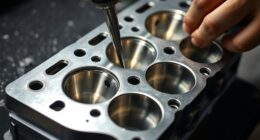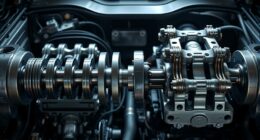Tuning your 2011 Ford Edge can turn it into a performance beast. Start with simple modifications like a Cold Air Intake and a Magna Flow exhaust to enhance efficiency and power. You’ll see modest horsepower gains, with peak outputs hitting around 221. 7 HP at the wheels after dyno testing. Understanding drivetrain losses, especially in all-wheel-drive systems, is key to maximizing your upgrades. As you tweak your vehicle, real-world performance will improve over time. Plus, joining the Ford Edge community offers valuable insights and support. Keep exploring, and you’ll uncover even more tuning tips and tricks! Consider upgrading the suspension and brakes to further enhance the handling and stopping power of your Ford Edge. Additionally, exploring different tuning software options can optimize the engine and transmission settings for even greater performance gains. Joining forums and attending meetups focused on Ford Edge performance tuning can provide a wealth of knowledge and resources for fine-tuning your vehicle to its maximum potential.
Key Takeaways
- Upgrading to a Cold Air Intake (CAI) and Magna Flow exhaust can slightly boost horsepower and enhance engine efficiency in the Ford Edge 2011.
- Regular dyno testing helps establish performance benchmarks and track improvements post-tuning, revealing true horsepower gains after modifications.
- Understanding drivetrain losses is essential; AWD configurations can experience up to 28% reduction in power delivered to the wheels.
- Installing a Pedal Commander optimizes throttle response, allowing for a more engaging driving experience with various driving modes.
- Engaging with the Ford Edge community fosters knowledge sharing on effective tuning practices and real-world performance outcomes.
Understanding Performance Modifications
When tuning your 2011 Ford Edge Sport, it's crucial to understand how performance modifications can impact your vehicle's efficiency and power. Upgrades like a cold air intake (CAI) and a Magna Flow exhaust are popular choices among enthusiasts for enhancing engine performance.
While these modifications can improve sound and efficiency, don't expect dramatic horsepower increases. Often, you'll see only modest gains in power, with real-world results sometimes falling short of theoretical expectations.
For instance, after tuning, your Edge Sport might achieve a peak output of 221.7 HP at the wheels. It's important to remember that drivetrain losses, estimated at around 20%, can affect overall performance. This means your actual gains might be less than what the numbers suggest on paper.
As you dive deeper into Ford tuning, keep in mind that future modifications and additional mileage can lead to better results. Initial dyno figures mightn't tell the whole story; as your engine breaks in and you make further adjustments, performance can improve.
Evaluating Dyno Test Results
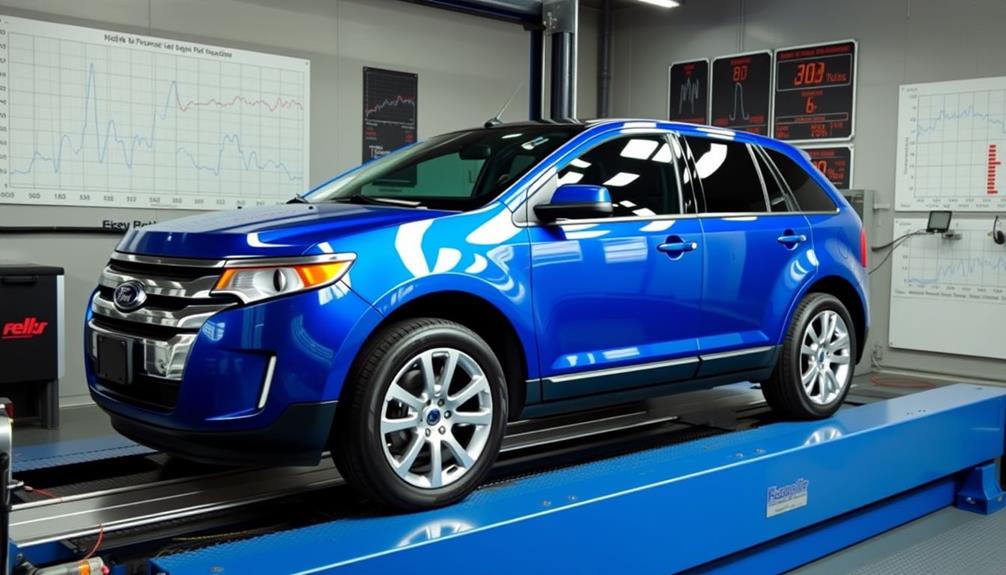
Evaluating dyno test results is essential for understanding the effectiveness of your tuning modifications on the 2011 Ford Edge Sport. After modifications, your vehicle showed a peak output of 221.7 HP at the wheels, reflecting considerable power gains over the stock performance.
Initially, during the cold run, it recorded only 185 HP, underscoring how critical it's to warm up your engine for accurate testing.
One important observation is the air to fuel ratio drop around 4200 RPMs during the initial run, which tuning corrected for smoother acceleration. These adjustments not only improve performance but also guarantee a more consistent driving experience.
Additionally, keep in mind that the estimated drivetrain loss was around 120 HP, leading to a 28% reduction from engine to wheels. This highlights how drivetrain efficiency can considerably affect your overall performance assessments.
Also, be aware that different dyno types yield varying results. For instance, Mustang dyno results typically show lower horsepower numbers than those from Dynojet, which could account for some discrepancies in reported power gains.
Types of Dyno Testing

When tuning your Ford Edge, understanding the differences between dyno types is essential.
You'll encounter Mustang dynos, which simulate real road conditions, and Dynojet, which often shows higher peak numbers.
Additionally, factors like elevation can drastically affect your results, so it's important to take into account all these elements for accurate performance assessments.
Mustang Vs. Dynojet Differences
Understanding the differences between Mustang and Dynojet dynos is essential for anyone looking to tune their Ford Edge or any other performance vehicle.
Mustang dynos typically provide lower horsepower numbers because they feature a loaded system design that simulates real road conditions. This design accounts for drivetrain losses more accurately, giving you a realistic view of your vehicle's performance.
In contrast, Dynojet dynos operate unloaded, often yielding higher and more consistent horsepower readings.
For instance, a Roush vehicle recorded 345 rwhp on a Mustang dyno, but it achieved 380 hp on a Dynojet. This discrepancy highlights the variability between the two types of dynos. While Dynojet can showcase significant potential gains, it may overshoot what you can realistically expect on the road.
Environmental factors like elevation can further complicate comparisons, with a potential 20% power loss at high altitudes.
To get meaningful results, consider performing stock dyno tests on both dyno types before modifications. This will give you valuable baseline comparisons to gauge the effectiveness of your tuning and performance upgrades.
Loaded Vs. Unloaded Testing
Precision in performance testing hinges on the choice between loaded and unloaded dyno methods. When tuning your Ford Edge, understanding these differences is critical.
Loaded dynos, such as Mustang dynos, simulate real-world driving conditions by applying resistance during testing. This creates a more accurate representation of horsepower, allowing you to gauge your vehicle's true performance potential under load. While loaded dynos typically yield lower horsepower figures, they provide insights that are more reflective of on-road driving.
In contrast, unloaded dynos, like Dynojet, operate without resistance, often resulting in higher horsepower numbers. Although these results are consistent, they may not accurately depict how your vehicle will perform in real-world scenarios. Consequently, while unloaded dynos can be useful for specific applications, they might mislead you when evaluating modifications on your Ford Edge Sport.
Ultimately, the choice between loaded and unloaded testing can greatly impact your tuning outcomes. If you're after genuine performance gains, loaded dynos are the way to go, ensuring your modifications translate well to actual driving conditions.
Understanding these testing methods will help you make informed decisions, enhancing your crossover's performance capabilities.
Impact of Elevation Factors
Elevation factors play an important role in tuning your Ford Edge, especially when it comes to dyno testing. As you venture into high altitudes, the decreased air density can lead to a significant 20% loss in horsepower for naturally aspirated engines. This makes it vital to take elevation into account when evaluating your vehicle's performance.
When testing your Ford Edge on a dyno, here are four key points to keep in mind regarding elevation:
- Dyno Type Matters: Mustang dynos simulate real-world load conditions but may show lower horsepower numbers compared to Dynojet dynos, which operate unloaded.
- Baseline Testing: Conduct stock dyno tests before modifications to establish a reliable baseline. This helps you gauge the effectiveness of any performance upgrades you make later.
- Calibration Variability: Different dyno setups can lead to variability in horsepower readings, so multiple tests are often necessary for accurate comparisons.
- Real-World Relevance: Loaded dynos like the Mustang are better for evaluating performance as they replicate actual driving conditions more closely than unloaded systems.
Understanding these factors will aid you in optimizing your Ford Edge for any elevation.
Community Feedback and Insights

The Ford Edge community has been instrumental in shaping tuning practices and sharing valuable insights. Through community feedback, members have discovered that simple modifications like a cold air intake and exhaust may yield only slight horsepower increases initially.
However, many have reported noticeable real-world performance improvements as mileage and tuning adjustments progressed. Discussions often emphasize the importance of distinguishing between engine horsepower and wheel horsepower. Users recommend conducting further dyno tests to accurately assess performance gains post-tuning.
For instance, initial dyno results for the modified Ford Edge Sport showed a peak output of only 221.7 HP at the wheels, which was considerably lower than many expected. Additionally, community members have shared their experiences of test driving other Edge Sports to compare performance, highlighting the variability in tuning outcomes.
This reinforces the need for ongoing collaboration on performance tests. By sharing dyno results and insights, you can gain a better understanding of tuning effectiveness for your Ford Edge. The collective knowledge and support within the community are invaluable for optimizing modifications and enhancing your driving experience.
Powertrain Dynamics Explained
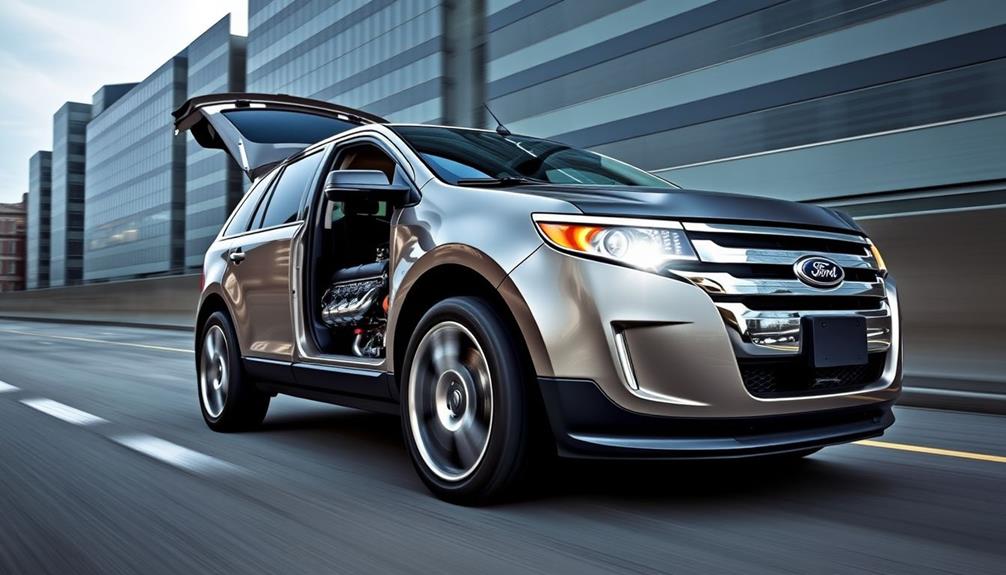
When tuning your 2011 Ford Edge, understanding drivetrain losses is essential, as they can greatly affect your car's performance.
If you opt for all-wheel drive, you'll notice about a 10% power loss compared to front-wheel drive, which impacts how power reaches the wheels.
Drivetrain Losses Explained
Drivetrain losses, often overlooked yet critical, refer to the power reduction that occurs as engine output travels to the wheels. For most vehicles, including your 2011 Ford Edge Sport, you can expect to lose around 20% of the engine's horsepower before it reaches the wheels. This means that if your engine produces 300 HP, only about 240 HP is available for driving.
Understanding drivetrain losses is essential when tuning your vehicle. Here are a few key points to evaluate:
- Power Loss: With an estimated 120 HP lost in the Ford Edge Sport, tuning efforts must account for this reduction.
- AWD vs. FWD: All-Wheel Drive vehicles typically experience about 10% more drivetrain losses due to extra components.
- Elevation Effects: High altitudes can further decrease performance, especially in naturally aspirated engines, which may see a 20% drop.
- Performance Modifications: Always factor in drivetrain losses to accurately gauge the impact of any performance upgrades you make.
AWD Vs. FWD Performance
Understanding the differences in performance between All-Wheel Drive (AWD) and Front-Wheel Drive (FWD) is key for anyone tuning a 2011 Ford Edge. AWD systems generally lose about 10% of power due to the extra components needed to send power to all four wheels. This results in a significant reduction of around 28% from engine output to wheels, especially evident in dyno results after tuning.
While AWD improves traction and stability in poor weather, it doesn't always translate to better horsepower at the wheels compared to FWD.
On the flip side, FWD configurations often allow you to harness more raw power, making them quicker in straight-line performance. However, AWD vehicles can provide a more balanced driving experience, enhancing handling and cornering capabilities.
If you modify your Edge's AWD system correctly, you can achieve impressive figures around 270-280 all-wheel horsepower (AWHP) or more.
Upcoming Dyno Testing Plans
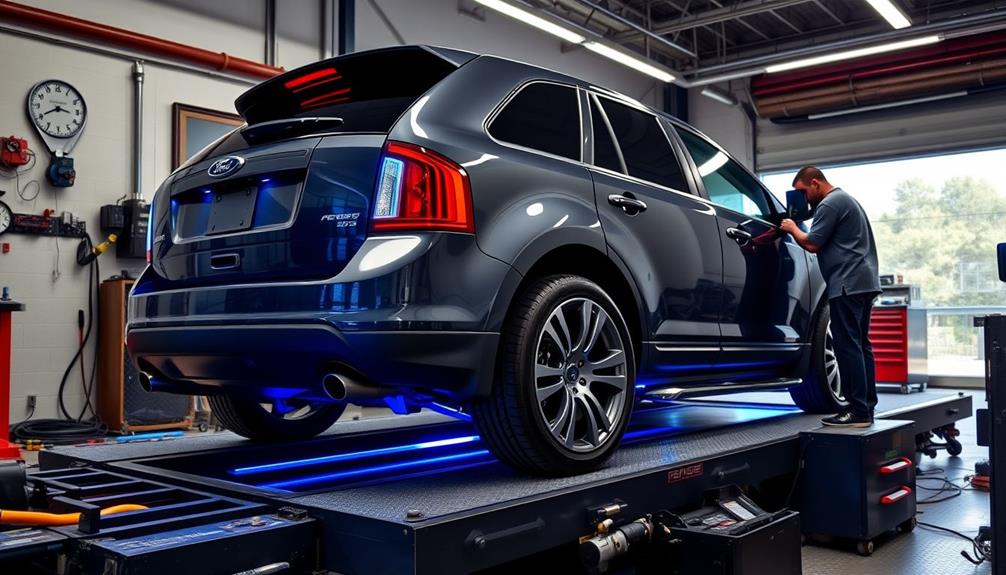
Exciting plans are underway for dyno testing on a stock 2011 Ford Edge Sport to establish baseline performance metrics.
You'll witness firsthand how your vehicle's performance can transform with the right modifications. The initial run will give you a solid benchmark before diving into enhancements like a Prozenmotorsports Cold Air Intake and a Magna Flow exhaust.
Here's what to expect from the upcoming dyno testing:
- Baseline Metrics: The first dyno run will measure your Edge's current horsepower and torque, helping you understand its starting point.
- Tuned Run: After modifications, a second run will assess the performance impacts, potentially reaching 270-280 AWHP or more.
- Dyno Comparisons: You'll learn about the differences between Mustang and Dynojet setups, emphasizing the importance of choosing the right dyno for accurate assessments.
- Community Sharing: Engage with fellow enthusiasts as you share your results, fostering discussions on performance gains achieved through tuning and modifications.
Enhancing Vehicle Technology

Enhancing vehicle technology in your 2011 Ford Edge Sport can greatly elevate your driving experience. One effective aftermarket upgrade is the Pedal Commander, which optimizes throttle response and improves overall performance without requiring extensive modifications.
This device features four driving modes—ECO, Sport, City, and Sports Plus—allowing you to tailor your driving dynamics based on your needs and conditions.
With its simple plug-and-play installation, you can skip the mechanic fees and enjoy immediate performance boosts. The Pedal Commander not only enhances acceleration but also contributes to overall vehicle efficiency, helping you achieve better fuel economy and reduced emissions.
Investing in such affordable aftermarket technologies is a smart choice for Ford owners looking to maximize control over their vehicles.
By integrating these advanced upgrades, you'll experience a driving transformation that makes your 2011 Ford Edge Sport feel more responsive and engaging.
Whether you're maneuvering through city streets or hitting the highway, these enhancements guarantee you're always in command, making your everyday drives much more enjoyable.
Industry Trends and Challenges

The automotive industry is currently maneuvering a complex landscape filled with significant challenges and evolving trends. As a Ford owner or enthusiast, you should pay attention to how these factors might influence your vehicle's performance and reliability.
1. Quality Assurance: Major brands, including Ford, face recall challenges that spotlight systemic manufacturing issues. This can affect the availability of performance parts.
The emphasis on quality assurance in software development reflects a broader trend of ensuring high standards across industries, including automotive.
2. Aging Workforce: An aging workforce in manufacturing has created skill gaps, impacting production efficiency and quality.
3. Long-term Investments: Companies are shifting focus, prioritizing long-term quality improvements over quick cost savings. This means better durability and performance for your vehicle.
4. Fuel Economy Innovations: With competition heating up, automakers are investing in technologies that enhance fuel economy, making vehicles more appealing to consumers.
Balancing innovation with user-friendly designs is vital. Excessive in-car technology can detract from the driving experience, a factor many consumers aren't thrilled about.
You can expect Ford and other manufacturers to adapt to these trends, aiming for better quality assurance and competitive performance that aligns with customer expectations. Staying informed will help you make smart choices for tuning your Ford Edge 2011 and transforming it into a true performance beast.
Frequently Asked Questions
How Much Horsepower Does a 2011 Ford Edge Limited Have?
The 2011 Ford Edge Limited has a factory-rated horsepower of 285 HP at the crank. After drivetrain losses, you'll typically see around 230-240 HP at the wheels, depending on various performance factors.
What Does Crossover Mean in Ford Edge?
A crossover blends the best of both worlds—car-like comfort and SUV versatility. In your Ford Edge, this means a spacious interior, higher driving position, and improved fuel efficiency, making it ideal for families and commuters alike.
Do Ford Edges Have Sport Mode?
Yes, Ford Edges do have a sport mode. When you engage it, you'll notice quicker acceleration and enhanced handling. It transforms your driving experience, making it more dynamic and enjoyable for spirited situations.
What Chassis Is the Ford Edge Built On?
The Ford Edge is built on the CD3 platform, which supports a weight-saving design. Its high-strength steel chassis enhances safety and structural integrity, giving you a reliable and spacious crossover for everyday driving adventures.
Conclusion
In transforming your 2011 Ford Edge into a performance beast, you're not just making modifications—you're crafting a driving experience that echoes with power and precision. As you embrace the latest tuning trends and community insights, remember: every tweak you make is a step toward revealing your vehicle's true potential. So, why settle for ordinary when extraordinary lies just a few enhancements away? Immerse yourself in the world of performance tuning and let your Edge roar like never before!








